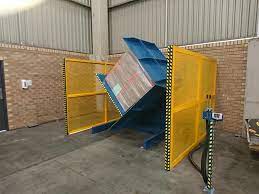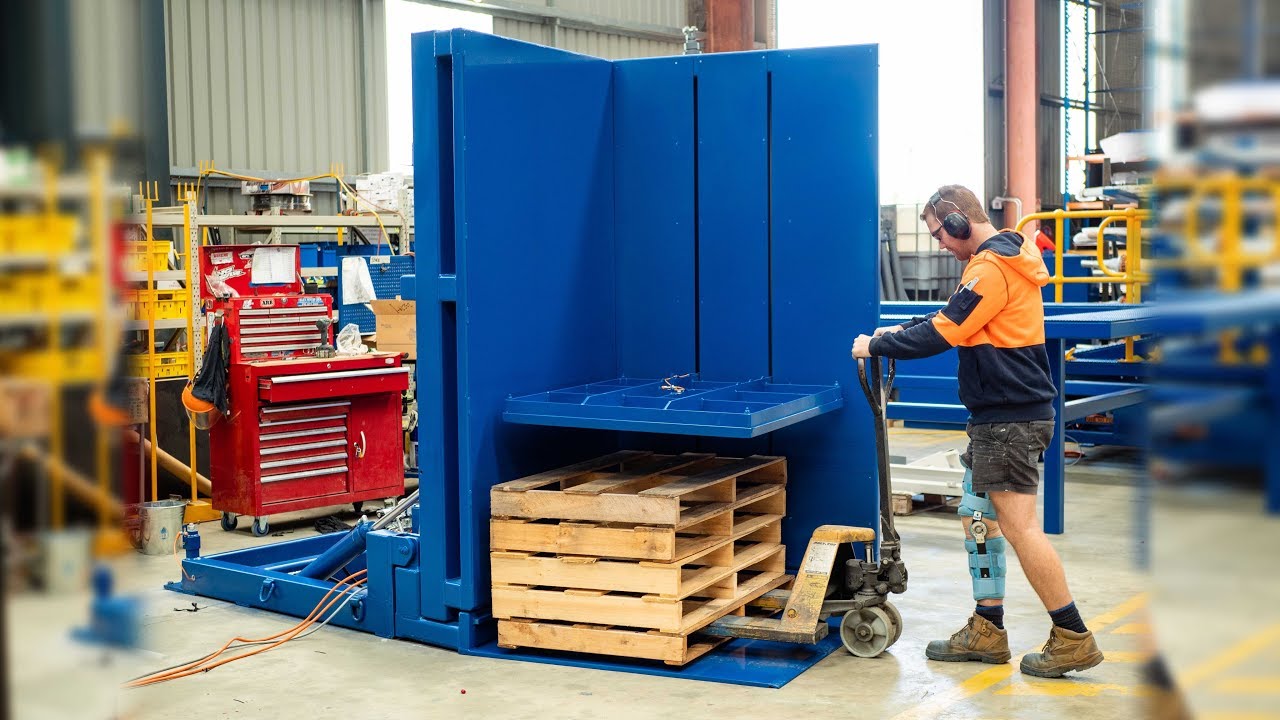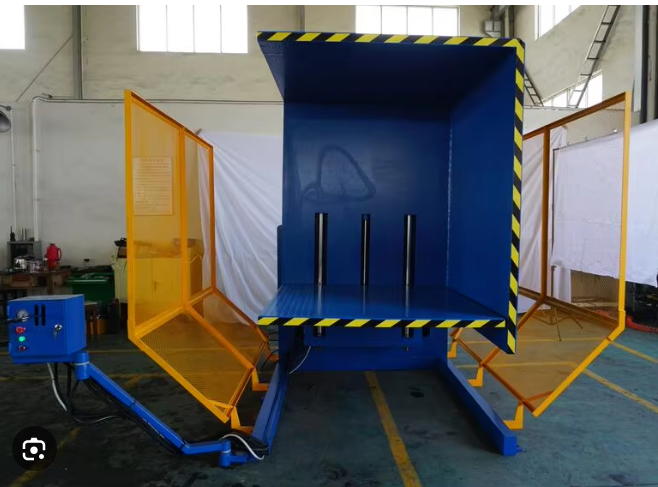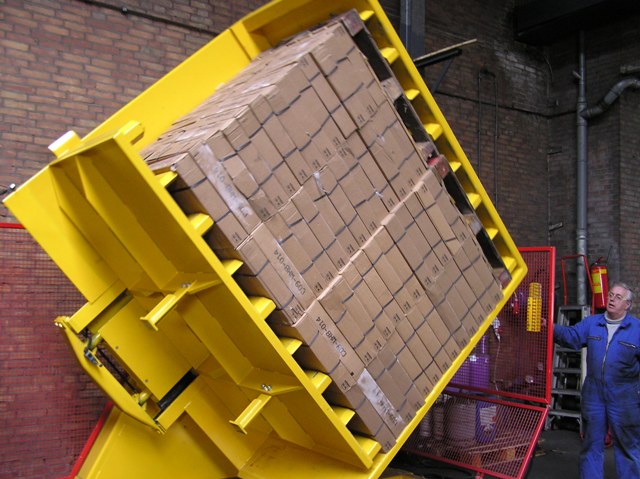Pallet Inverter: What’s the Best Way to Handle Slippery Frozen Pallets?
Handling materials in a busy warehouse or factory presents many challenges. But when you add ice and condensation, a simple task becomes a major risk. I'm talking about frozen pallets. Every time your team needs to move or switch a pallet of frozen goods, you face a slippery, unstable load. A single mistake can lead to damaged products, costly cleanups, and even serious injuries. You might think a standard pallet inverter is the answer, but they often make the problem worse by applying too much pressure, crushing the very goods you're trying to protect. This constant risk eats away at your efficiency and your profits.
The best way to handle slippery frozen pallets is by using a specialized 180-degree pallet inverter. These machines are designed to securely clamp the load from the top and bottom with adjustable pressure. Then, they rotate the entire load a full 180 degrees. This process allows you to replace a pallet safely and gently without crushing the product or risking slippage. It is the most secure, efficient, and damage-free method for managing unstable, frozen goods.

I've spent over two decades in the packing and handling industry, first as an engineer and now as a factory owner. I've helped clients like you tackle some of the toughest material handling problems. The issue with frozen pallets comes up often. It’s a perfect example of how a standard solution can fail when faced with a specific challenge. In this article, I want to share what I've learned. We'll look at why standard inverters fail with frozen goods. We'll explore the specific features that make a specialized inverter work. And we'll talk about how this investment pays for itself. Let’s dive in.
Why Are Standard Pallet Inverters Risky for Frozen Goods?
You see a problem: your team is struggling to switch out damaged pallets under heavy, frozen loads. It’s slow and dangerous. So, you invest in a standard pallet inverter, expecting it to solve the issue. But soon, new problems appear. Boxes of frozen goods are being crushed. Loads are still shifting during the transfer. The new machine isn't delivering the safety or efficiency you paid for. Now you have a costly piece of equipment that is creating product waste instead of solving a problem.
Standard pallet inverters are risky for frozen goods because they typically use high, often non-adjustable, clamping pressure from the sides to secure a load. This brute-force approach is unsuitable for frozen items. The ice and condensation make surfaces extremely slippery, and the rigid, frozen nature of the products means they can't absorb pressure. Instead, they break or crush. This method fails to provide the stable, gentle handling that frozen pallets require.

In my experience, choosing the right tool for the job is everything. A standard pallet inverter is a great tool, but not for this specific job. Let's break down exactly why it falls short when dealing with the unique physics of a frozen load. It’s not just about the machine itself, but about understanding the forces at play. Understanding these weaknesses is the first step toward finding a solution that truly protects your products, your people, and your profits.
The Problem of Excessive Clamping Pressure
Standard inverters, especially older or more basic models, often operate like a simple vise. They push from two sides to hold the load in place. For stable, dry goods like canned drinks or paper reams, this works perfectly well. The products can handle the pressure. But frozen goods are different. Imagine a pallet of frozen fish fillets in cardboard boxes. The boxes are rigid. The contents are solid. When a standard inverter applies side pressure, the force isn't distributed evenly. It concentrates on the outer boxes, crushing corners and damaging the packaging. This not only ruins the product but also compromises the structural integrity of the entire pallet, making it even more unstable. The machine designed to increase stability ends up creating a bigger hazard.
The Failure to Contain Slippery Surfaces
The second critical flaw is how standard inverters handle the "slippery" factor. Condensation on frozen packaging creates a low-friction surface. When the inverter tilts or rotates the load, gravity pulls the boxes downward. A standard machine relies solely on side pressure to counteract this. But on an icy surface, that pressure isn't enough to create the necessary friction. Boxes in the middle of the stack, which aren't even touched by the clamps, can easily slide out. I've seen entire layers of product cascade out of a machine during an operation. This is a catastrophic failure that results in massive product loss and significant downtime for cleanup. It’s a direct consequence of a design that doesn’t account for the unique properties of frozen goods.
A Comparison of Inverter Technologies
To make it clearer, let's compare the fundamental approach of a standard inverter versus one designed for your challenge. As an engineer, I always find that a side-by-side comparison makes the choice obvious.
| Feature | Standard Pallet Inverter | Specialized Frozen Goods Inverter |
|---|---|---|
| Clamping Method | High-pressure side clamps | Adjustable top and bottom pressure plates |
| Load Stability | Relies on friction from side pressure | Cradles the entire load, eliminating slippage |
| Product Safety | High risk of crushing and damage | Gentle handling protects product integrity |
| Operation Angle | Typically 90-120 degrees | Full 180-degree rotation |
| Suitability | Best for stable, dry, robust goods | Ideal for slippery, fragile, or unstable loads |
As you can see, the machines are engineered for completely different tasks. For a business leader like you, Javier, who analyzes every investment for ROI and stability, using the wrong machine is not just inefficient; it's a direct threat to your operational goals.
What Features Make a Pallet Inverter Safe for Icy Loads?
Your team is frustrated. You're losing money on damaged frozen products. The standard equipment you have is not working. You know there must be a better way, a machine designed specifically for this challenge. You start searching for a solution, but the market is full of options. How do you identify the specific features that will actually solve your problem? You need to know what to look for to ensure your next investment is the right one, one that delivers safety and efficiency from day one.
A pallet inverter is made safe for icy loads through three key features: a 180-degree rotation mechanism, top and bottom clamping plates, and adjustable pressure control. The 180-degree rotation allows for a smooth, gravity-assisted transfer. The top and bottom plates secure the entire load, preventing any internal slippage. Finally, adjustable pressure ensures the machine applies just enough force to hold the load securely without crushing the fragile, frozen products.

From my years designing and building these machines, I can tell you that the difference between success and failure lies in the details. It's about engineering a machine that works with the laws of physics, not against them. A specialized pallet inverter for frozen goods isn't just a stronger machine; it's a smarter one. Let's look closer at the specific components that make this technology so effective. These are the details you should be asking about when you talk to a potential supplier.
Full 180-Degree Inversion with Solid Support
The heart of the solution is the ability to turn the entire pallet upside down completely. A machine with 180-degree capability, often called a pallet exchanger or pallet rotator, works differently than a simple 90-degree tipper. The process is simple but brilliant. The forklift places the pallet into the inverter. A solid platform from the top comes down to press gently on the load. This platform and the base of the machine effectively create a secure box around your products. Then, the entire unit rotates a full 180 degrees. The new pallet is placed on top, and the machine rotates back. Gravity does most of the work. The load is never suspended at an odd angle where it can slide. It is always fully supported, either by the original pallet, the new pallet, or the machine's steel platform. This eliminates the risk of products slipping out.
Adjustable Clamping Pressure Control
This feature is non-negotiable for handling frozen goods. As we discussed, too much pressure crushes products. Too little, and the load isn't secure. A specialized inverter must have a sophisticated hydraulic system with a user-friendly control panel. This allows your operator to set the precise clamping pressure needed for different types of products. For delicate boxes of frozen pastries, you might use a very low pressure. For more robust frozen blocks of meat, you can use a bit more. A pressure gauge should be clearly visible, so the operator can be certain they are using the correct setting every time. This level of control turns a potentially destructive process into a delicate, precise operation. It puts the power to protect your products directly into your team's hands.
Critical Features for Safe Operation
Beyond the core mechanics, several features contribute to a safe and efficient system. Here’s a breakdown of what a top-tier machine should include:
| Essential Feature | Benefit for Handling Frozen Pallets | Impact on Operations |
|---|---|---|
| Top & Bottom Platforms | Cradles the load, preventing internal and external slippage. | Eliminates product loss during transfer. |
| Adjustable Pressure Gauge | Allows fine-tuning of force for different products. | Prevents crushing damage to fragile goods. |
| Safety Fencing & Light Curtains | Creates a safe zone, automatically stopping the machine if someone enters. | Protects employees from injury, reducing liability. |
| PLC Control System | Automates the inversion sequence for consistent and reliable operation. | Reduces operator error and increases throughput. |
| Fork Pockets for Mobility | Allows the inverter to be moved easily with a forklift. | Provides flexibility in warehouse layout and workflow. |
When you are assessing a new machine, think of it like building a team. You need every component to do its job perfectly. These features work together to create a system that is not only effective but also safe and reliable for the long haul. This is the kind of robust engineering that a forward-thinking leader like you, Javier, should demand.
How Does a Specialized Pallet Inverter Boost Warehouse ROI?
As a business owner, every decision comes down to the numbers. You're facing rising energy costs, aging equipment, and pressure to improve your bottom line. Investing in new machinery is a significant capital expense. You can't afford to buy equipment that doesn't deliver a clear and substantial return on investment (ROI). You're asking the right question: "How will this machine make my operation more profitable?" The sticker price is just one part of the equation. The real value is in the money it saves and the efficiency it creates every single day.
A specialized pallet inverter boosts warehouse ROI in three primary ways: it drastically reduces product damage, it lowers labor costs by speeding up the pallet exchange process, and it improves operational uptime by preventing accidents and cleanups. By eliminating the cost of lost goods and making your team more efficient, the machine quickly pays for itself and contributes directly to a higher overall profit margin.

I've worked with many clients who were hesitant about the initial investment. But after a few months, the data always tells the same story. The savings are real and they are significant. Let's move beyond theory and look at the practical financial impact. We can break down the ROI into concrete, measurable components that you can apply to your own operational data. This is how you build a business case for an investment that makes financial sense.
Calculating the Reduction in Product Damage
This is the most direct and often the largest area of savings. First, you need to calculate your current cost of damage. Track how many frozen pallets require a transfer each month. Then, estimate the percentage of products that are damaged during this manual or semi-automated process. Let's use a conservative example.
- Pallets Transferred per Month: 100
- Average Value per Pallet: $2,000
- Current Damage Rate: 5% (due to crushing, dropping)
- Monthly Loss: 100 pallets 5% $2,000/pallet = $10,000
A specialized pallet inverter is designed to eliminate this type of damage. Its gentle, secure handling can reduce this damage rate to virtually zero. That’s a potential saving of $10,000 per month, or $120,000 per year. This single metric can often justify the entire cost of the machine in a very short period. This is a direct impact on your goal to lower operational costs.
Measuring Labor Savings and Increased Throughput
Time is money in any industrial operation. Consider the manual process of swapping a pallet. It might take two or three employees 20-30 minutes. They have to de-stack the pallet box by box, restack it on the new pallet, and then re-wrap it. It's slow, physically demanding, and introduces multiple opportunities for error. A pallet inverter can complete the same task in about 2-3 minutes with a single operator.
Let's do the math:
- Manual Time: 25 minutes with 2 workers
- Inverter Time: 3 minutes with 1 operator (including forklift travel)
The time savings are massive. This frees up your employees to work on other value-added tasks. It also dramatically increases your throughput. If you have a bottleneck at the pallet transfer station, this machine can eliminate it. This directly supports your goal of increasing capacity utilization to 95%. When equipment runs smoothly and efficiently, your entire production line benefits.
Sample ROI Payback Analysis
As a practical entrepreneur, you want to see the payback period. Let's put these numbers into a simplified table.
| Cost & Savings Analysis | Amount (USD) | Notes |
|---|---|---|
| Investment | ||
| Machine Cost | -$50,000 | (Example Cost) |
| Monthly Savings | ||
| Reduced Product Damage | +$10,000 | Based on 5% damage rate on $200k of product |
| Labor Savings | +$3,000 | (e.g., 1.5 FTEs reassigned) |
| Net Monthly Savings | $13,000 | |
| Payback Period | ~3.8 Months | ($50,000 / $13,000 per month) |
This is a simplified model, but it illustrates the powerful financial case. A payback period of less than half a year is a compelling proposition for any CEO. It's not just an expense; it's a strategic investment in efficiency and profitability.
What Are the Long-Term Benefits Beyond Just Handling Frozen Pallets?
You're a strategic thinker, Javier. You're not just solving today's problem with frozen pallets. You're looking at the bigger picture. You're planning for the next 5, 10, or 15 years. So, you're rightfully asking, "What else can this machine do for me? Is this a single-task solution, or is it a versatile asset that will grow with my business?" This is a critical question. The best investments are those that provide value across your entire operation and adapt to future needs.
The long-term benefits of a specialized pallet inverter extend far beyond handling frozen goods. It provides operational versatility to handle a wide range of unstable loads, enhances employee safety and morale by eliminating a dangerous task, and helps future-proof your logistics by integrating into automated systems. It becomes a flexible tool that improves overall warehouse resilience and efficiency.

In my journey of building SHJLPACK, I learned that durable, versatile equipment is the foundation of a resilient business. A machine that solves only one niche problem can become obsolete if your product mix changes. But a machine built on flexible, intelligent principles becomes a cornerstone of your operations for years to come. Let's explore how this investment pays dividends in ways you might not have initially considered.
Versatility Across Different Product Lines
While we've focused on frozen pallets, the core challenge is handling unstable loads. The principles of gentle, secure, 180-degree inversion apply to many other products. Think about what else you might handle now or in the future:
- Bags and Sacks: Pallets of grain, cement, or chemicals in sacks are notoriously unstable. A pallet inverter can transfer them without risk of tearing bags or toppling the stack.
- Barrels and Drums: Transferring heavy barrels from a wooden pallet to a plastic, hygienic one is a common need. The inverter handles this with ease.
- Bottled Goods: Tall, unstable loads of bottled liquids can be transferred safely without damaging caps or labels.
- Heavy Industrial Components: In your industry, Javier, you might need to transfer heavy, oiled parts from an in-house pallet to a shipping pallet. A heavy-duty inverter can manage this, preventing damage and improving safety.
This versatility means the machine will not sit idle. It becomes a central utility in your warehouse, adaptable to changing market demands and product lines. This aligns with your challenge of managing market fluctuations by making your internal logistics more flexible.
Improving Employee Safety and Morale
The long-term impact on your workforce is significant. Manually handling heavy, slippery loads is one of the most common causes of back injuries, strains, and accidents in a warehouse. These injuries lead to lost workdays, increased insurance premiums, and lower employee morale. By automating this dangerous task, you are making a clear statement to your team: their safety matters.
A safer workplace is a more productive workplace. When employees feel valued and protected, morale improves. They are more engaged and more likely to follow other safety protocols. This cultural shift is harder to quantify on a spreadsheet than product damage, but its long-term value is immense. It helps build a stable, experienced workforce—a key asset for any successful company.
Future-Proofing for Automation and Digitalization
You have a clear goal to advance your company's digital transformation. A modern pallet inverter is not just a standalone mechanical device. It is an intelligent piece of equipment. With its PLC control system, it can be integrated into a larger Warehouse Management System (WMS) or Manufacturing Execution System (MES).
- Data Collection: It can track the number of pallets inverted, cycle times, and fault codes, providing valuable data for your analytics platforms.
- Automation: It can be integrated into a fully automated line with conveyors and Automated Guided Vehicles (AGVs). The inverter becomes a key station in a hands-free logistics flow.
Investing in this type of smart equipment today prepares you for the automated warehouse of tomorrow. It’s a foundational step in building a fully connected, visible, and efficient production environment, directly supporting your goal of deploying MES and IoT technologies.
My Insights
Javier, when I look at your profile, I see a leader who has built a major enterprise from the ground up. You’ve moved from the factory floor to the CEO’s office. You understand the machinery, and you understand the business. We have a similar background, and I respect that journey.
You're not just looking for a machine. You're looking for a strategic partner who can provide a total solution. You need someone who understands your challenges with aging equipment, cost pressures, and the need for digital transformation.
In my experience, the best solution to a complex problem is often the one that is engineered with simplicity and intelligence. The problem of slippery, frozen pallets is a perfect example. Brute force—the standard inverter's approach—fails. It crushes the product and creates instability. The intelligent solution is to work with gravity, not against it. A 180-degree inverter that cradles the load is that intelligent solution. It’s a design that respects the product it handles.
This philosophy extends to everything we do at SHJLPACK. Whether it’s a pallet inverter or a steel coil wrapping line, our goal is to provide solutions that are robust, efficient, and smart. We aim to build equipment that doesn’t just do a job, but makes your entire operation stronger. It reduces waste, improves safety, and gives you a reliable platform for growth. That's how a capital investment stops being an expense and starts becoming a true competitive advantage. It's the kind of partnership I believe you're looking for.
Conclusion
A specialized pallet inverter is the safest, most efficient way to handle frozen pallets, reducing damage and boosting ROI. It is a versatile, long-term asset for any modern warehouse.




